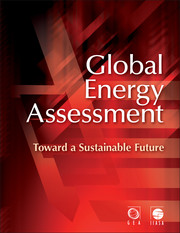Book contents
- Frontmatter
- Contents
- Section 1
- Section 2
- Section 3
- Cluster 1
- Cluster 2
- Cluster 3
- Chapter 17 Energy Pathways for Sustainable Development
- Chapter 18 Urban Energy Systems
- Chapter 19 Energy Access for Development
- Chapter 20 Land and Water: Linkages to Bioenergy
- Chapter 21 Lifestyles, Well-Being and Energy
- Cluster 4
- Section 4
- Index
- References
Chapter 17 - Energy Pathways for Sustainable Development
Published online by Cambridge University Press: 05 September 2012
- Frontmatter
- Contents
- Section 1
- Section 2
- Section 3
- Cluster 1
- Cluster 2
- Cluster 3
- Chapter 17 Energy Pathways for Sustainable Development
- Chapter 18 Urban Energy Systems
- Chapter 19 Energy Access for Development
- Chapter 20 Land and Water: Linkages to Bioenergy
- Chapter 21 Lifestyles, Well-Being and Energy
- Cluster 4
- Section 4
- Index
- References
Summary
Executive Summary
Chapter 17 explores possible transformational pathways of the future global energy system with the overarching aim of assessing the technological feasibility as well as the economic implications of meeting a range of sustainability objectives simultaneously. As such, it aims at the integration across objectives, and thus goes beyond earlier assessments of the future energy system that have mostly focused on either specific topics or single objectives. Specifically, the chapter assesses technical measures, policies, and related costs and benefits for meeting the objectives that were identified in Chapters 2 to 6, including:
providing almost universal access to affordable clean cooking and electricity for the poor;
limiting air pollution and health damages from energy use;
improving energy security throughout the world; and
limiting climate change.
The assessment of future energy pathways in this chapter shows that it is technically possible to achieve improved energy access, air quality, and energy security simultaneously while avoiding dangerous climate change. In fact, a number of alternative combinations of resources, technologies, and policies are found capable of attaining these objectives. From a large ensemble of possible transformations, three distinct groups of pathways (GEA-Supply, GEA-Mix, and GEA-Efficiency) have been identified and analyzed. Within each group, one pathway has been selected as “illustrative” in order to represent alternative evolutions of the energy system toward sustainable development. The pathway groups, together with the illustrative cases, depict salient branching points for policy implementation and highlight different degrees of freedom and different routes to the sustainability objectives.
- Type
- Chapter
- Information
- Global Energy AssessmentToward a Sustainable Future, pp. 1205 - 1306Publisher: Cambridge University PressPrint publication year: 2012
References
- 26
- Cited by

